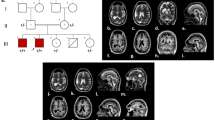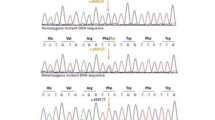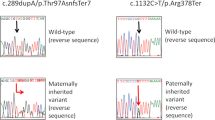Abstract
Autosomal recessive microcephaly is a rare clinical condition, which is characterized by reduced brain size that can be associated with delayed intellectual ability, developmental delay, and seizure. In this study, we describe two siblings with microcephaly: a 12-year-old girl with primary microcephaly, and a 7-year-old boy with secondary microcephaly, whose episodes of seizure and neurodevelopmental regression started at 6 years and 6 months of age, respectively. The interesting finding in these siblings was two different presentations of the same variant: one case with primary and one case with secondary microcephaly. Whole-exome sequencing was performed in order to identify causative variants in one family having two affected siblings with microcephaly. Confirmation of the identified variant in the ZNF335 gene in the proband and her affected brother and segregation analysis in the family were performed using the Sanger sequencing method. In both patients, a novel homozygous missense variant, [NM_022095.4: c.3346G>A; p.(Gly1116Arg)], in the ZNF335 gene was identified. The p.(Gly1116Arg) variant causes a defect in the last zinc finger domain of the protein. Conservation analysis by ConSurf server and UCSC genome browser revealed that Gly1116 is a highly conserved amino acid among different species. Different in-silico prediction tools and bioinformatics analysis predicted this variant as damaging.




Similar content being viewed by others
Availability of Data and Materials
The data that support the findings of this study are openly available in Sequence Read Archive (SRA), (Submission ID: SUB10725571 at https://submit.ncbi.nlm.nih.gov/subs/sra/SUB10725571/overview, (SRA number: SRR17053705), (BioProject ID: PRJNA783183), (BioSample ID: SAMN23421294). Human variant and pertinent phenotypes have been reported to ClinVar (Submission ID: SUB10485891; Accession ID: SCV001976525). https://submit.ncbi.nlm.nih.gov/subs/clinvar_wizard/ SUB10485891/overview
References
Abuín JM, Pichel JC, Pena TF, Amigo J (2015) BigBWA: approaching the Burrows-Wheeler aligner to Big Data technologies. Bioinformatics 31:4003–4005
Adzhubei IA, Schmidt S, Peshkin L, Ramensky VE, Gerasimova A, Bork P, Kondrashov AS, Sunyaev SR (2010) A method and server for predicting damaging missense mutations. Nat Methods 7:248–249
Ashkenazy H, Abadi S, Martz E, Chay O, Mayrose I, Pupko T, Ben-Tal N (2016) ConSurf 2016: an improved methodology to estimate and visualize evolutionary conservation in macromolecules. Nucleic Acids Res 44:W344–W350
Caglayan AO, Yaghouti K, Kockaya T, Kemer D, Cankaya T, Ameziane N, Cogulu O, Coker M, Yalcinkaya C (2020) Biallelic ZNF335 mutations cause basal ganglia abnormality with progressive cerebral/cerebellar atrophy. J Neurogenet 35:1–6
Capriotti E, Fariselli P, Casadio R (2005) I-Mutant2. 0: predicting stability changes upon mutation from the protein sequence or structure. Nucleic Acids Res 33:W306–W310
Chen S, Zhou Y, Chen Y, GU J (2018) fastp: an ultra-fast all-in-one FASTQ preprocessor. Bioinformatics 34:i884–i890
Darvish H, Esmaeeli-Nieh S, Monajemi G, Mohseni M, Ghasemi-Firouzabadi S, Abedini S, Bahman I, Jamali P, Azimi S, Mojahedi F (2010) A clinical and molecular genetic study of 112 Iranian families with primary microcephaly. J Med Genet 47:823–828
Deloukas P, Matthews L, Ashurst J, Burton J, Gilbert J, Jones M, Stavrides G, Almeida J, Babbage A, Bagguley C (2001) The DNA sequence and comparative analysis of human chromosome 20. Nature 414:865–872
Haeussler M, Zweig AS, Tyner C, Speir ML, Rosenbloom KR, Raney BJ, Lee CM, Lee BT, Hinrichs AS, Gonzalez JN, Gibson D, Diekhans M, Clawson H, Casper J, Barber GP, Haussler D, Kuhn RM, Kent WJ (2019) The UCSC genome browser database: 2019 update. Nucleic Acids Res 47:D853–D858
Hwang S, Kim E, Lee I, Marcotte EM (2015) Systematic comparison of variant calling pipelines using gold standard personal exome variants. Sci Report 5:1–8
Mohammadi P, Daneshmand MA, Mahdieh N, Ashrafi MR, Heidari M, Garshasbi M (2021a) Identification of a novel missense c. 386G> A variant in a boy with the POMGNT1-related muscular dystrophy-dystroglycanopathy. Acta Neurol Belg 121:143–151
Mohammadi P, Heidari M, Ashrafi MR, Mahdieh N, Garshasbi M (2021b) A novel homozygous missense variant in the NAXE gene in an Iranian family with progressive encephalopathy with brain edema and leukoencephalopathy. Acta Neurol Belg 121:1–10
Mohammadi P, Salehi Siavashani E, Mohammadi MF, Bahramy A, Almadani N, Garshasbi M, Medicine, G (2021c) Whole‐exome sequencing identified first homozygous frameshift variant in the COLEC10 gene in an Iranian patient causing 3MC syndrome type 3. Mol Genet Genomic Med e1834
Ng PC, Henikoff S (2003) SIFT: Predicting amino acid changes that affect protein function. Nucleic Acids Res 31:3812–3814
Nishida T, Mihara T, Horiki T, Ka K (2016) Anaesthesia and orphan disease: primary autosomal recessive microcephaly-10 caused by a mutation in the: ZNF335: gene. Eur J Anaesthesiol (EJA) 33:543–545
Rana R, Gwasikoti N, Vaswani ND, Kaushik JS (2019) Phenomenology of epilepsy in a child with a ZNF335 encephalopathy. Indian J Pediatr 86:967–968
Richards S, Aziz N, Bale S, Bick D, Das S, Gastier-Foster J, Grody WW, Hegde M, Lyon E, Spector E (2015) Standards and guidelines for the interpretation of sequence variants: a joint consensus recommendation of the American College of Medical Genetics and Genomics and the Association for. Mol Pathol 17:405–423
Sato R, Takanashi JI, Tsuyusaki Y, Kato M, Saitsu H, Matsumoto N, Takahashi T (2016) Association between invisible basal ganglia and ZNF335 mutations: a case report. Pediatrics 138
Schwarz JM, Rödelsperger C, Schuelke M, Seelow D (2010) MutationTaster evaluates disease-causing potential of sequence alterations. Nat Methods 7:575–576
Shihab HA, Rogers MF, Gough J, Mort M, Cooper DN, Day IN, Gaunt TR, Campbell C (2015) An integrative approach to predicting the functional effects of non-coding and coding sequence variation. Bioinformatics 31:1536–1543
Stouffs K, Stergachis AB, Vanderhasselt T, Dica A, Janssens S, Vandervore L, Gheldof A, Bodamer O, Keymolen K, Seneca S, Liebaers I, Jayaraman D, Hill HE, Partlow JN, Walsh CA, Jansen AC (2018) Expanding the clinical spectrum of biallelic ZNF335 variants. Clin Genet 94:246–251
Thornton GK, Woods CG (2009) Primary microcephaly: do all roads lead to Rome? Trends Genet 25:501–510
Yang YJ, Baltus AE, Mathew RS, Murphy EA, Evrony GD, Gonzalez DM, Wang EP, Marshall-Walker CA, barry BJ, Murn J, Tatarakis A, Mahajan MA, Samuels HH, Shi Y, Golden JA, Mahajnah M, Shenhav R, Walsh CA, (2012) Microcephaly gene links trithorax and REST/NRSF to control neural stem cell proliferation and differentiation. Cell 151:1097–1112
Acknowledgements
We thank all the participants in this research. The authors are especially thankful to the patients and their parents who took part in this study and also the personnel of the Children’s Medical Center for supporting us in this study. Also, we thank Iranian Genetic Foundation and Iranian Social Welfare.
Author information
Authors and Affiliations
Contributions
PM and MH conceived and designed the experiments. EHEM, PM, MRA, RH, ART, EP, and HGH conducted the experiments; PM, MH, ZR, RH, ART, and EHEM analyzed and interpreted the data. PM, EHEM, MH, RH, and MRA contributed reagents/materials/analysis tools. PM, RH, and MH wrote the paper. All the authors reviewed the manuscript.
Corresponding authors
Ethics declarations
Ethics Approval and Consent to Participate
The written informed consent was obtained from the parents as legal guardians of the proband and her affected brother. The study protocol was approved by the local medical ethics committee of Children’s Medical Center, Tehran, Iran. The study was being performed in accordance with the ethical standards laid down in the 1964 Declaration of Helsinki and its later amendments.
Consent for Publication
Not applicable
Competing Interests
The authors declare no competing interests.
Additional information
Publisher's Note
Springer Nature remains neutral with regard to jurisdictional claims in published maps and institutional affiliations.
Ali Reza Tavasoli and Elmira Haji Esmaeil Memar have equal contribution as the first authors.
Rights and permissions
About this article
Cite this article
Tavasoli, A.R., Memar, E.H.E., Ashrafi, M.R. et al. Primary and Secondary Microcephaly, Global Developmental Delay, and Seizure in Two Siblings Caused by a Novel Missense Variant in the ZNF335 Gene. J Mol Neurosci 72, 719–729 (2022). https://doi.org/10.1007/s12031-021-01955-y
Received:
Accepted:
Published:
Issue Date:
DOI: https://doi.org/10.1007/s12031-021-01955-y




